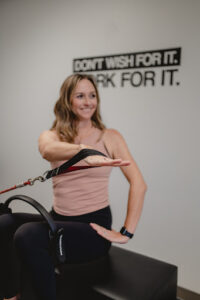I am a homegrown Arizona girl but I ventured out to Chicago, IL in 2005 to attend Northwestern University and obtain my doctorate in physical therapy. After graduating from Northwestern University, I traveled around the country and got to call some amazing places like Los Angeles, Nashville, and Philadelphia home. I eventually made my way back to the Grand Canyon state seven years ago with my husband and our one-year-old son. I needed a new exercise routine and stumbled upon a reformer Pilates class. I had been struggling with “getting my body back after baby”. I didn’t feel strong in my body anymore, especially in my core. I didn’t even feel like I had a core anymore following a 42-week pregnancy, 36hr labor, and a hard recovery post-cesarean section. I had been interested in Pilates but was, honestly, a bit intimidated by the reformer machine. I took the leap and fell in love with Pilates from the first class! I have been practicing Pilates two to three days a week since that first class in 2017.
I remember one specific Pilates class that changed the course of my professional career. We were finishing up the class and I remember thinking how amazing it would be to teach Pilates. My immediate thought was that I should become a Pilates instructor and teach Pilates for a living. After some serious contemplation, I realized that I could (and should!) still be a physical therapist but that I could (and should!) incorporate Pilates into my physical therapy practice. It was like a giant light bulb went off! Pilates and physical therapy are made for each other. Especially Pilates and pelvic floor physical therapy! Pilates centers around the importance of breathing and movement. Pelvic floor physical therapy centers around the importance of breathing and movement. It just took me a bit to connect the dots and realize how beneficial it would be to teach my pelvic floor physical therapy clients Pilates-based exercises as part of a comprehensive program. After researching different training programs, I registered for courses with Balanced Body Pilates, one of the country’s most reputable Pilates instructor training programs.
Diaphragmatic breathing is SO IMPORTANT! Our bodies are made to breathe using the diaphragm but, over time, many of us become shallow, chest breathers. If you watch a baby breathe, that baby is a diaphragmatic breather! The diaphragm is the primary muscle of respiration aka breathing and is located at the base of the lungs. When a person inhales, the diaphragm contracts and moves in a downward direction. This increases the volume of the thoracic (chest) cavity, decreases the intra-abdominal pressure, and allows the lungs to expand. When a person exhales, the diaphragm relaxes back up into the thoracic cavity and air is expelled by a mostly passive elastic recoil of the lungs. To add on another layer… when we inhale the diaphragm should descend, the ribcage should expand out, and the pelvic floor should relax. When we exhale, the pelvic floor should contract, the diaphragm relaxes back up, and the ribcage returns to the midline.
We want to use a diaphragmatic breathing pattern because it is the most efficient way to breathe. It allows for optimal gas exchange between the oxygen that we need and the carbon dioxide that we want to get rid of. Diaphragmatic breathing can lead to a lower heart rate which is beneficial to the entire cardiovascular system and can result in lower blood pressure. Diaphragmatic breathing promotes optimal muscle function during activities of daily living as well as during exercise. Chest breathing is inefficient, labor intensive, and makes breathing feel harder. Chest breathing tends to result in a faster breathing rate, and keeps the body in a more sympathetic nervous system state (our fight or flight response) which equates to feeling more stress and anxiety, and can contribute to upper back and neck pain. Chest breathing also negatively impacts the pelvic floor by reducing the ability of the pelvic floor to relax and can lead to pelvic floor tension, pain, pelvic organ prolapse, urinary incontinence, and sexual concerns.
We tend to become chest breathers over time due to poor posture (think excessive sitting throughout the day driving or at a computer), daily stress, decreased core strength, and bad habits like trying to suck in our stomachs to appear thinner. We also see a chest breathing pattern develop during pregnancy as the baby bump expands out and there isn’t as much room for the diaphragm to descend. The diaphragm does not always return to its full range of movement postpartum and it can be extremely beneficial to “retrain” the diaphragm to be able to fully descend. A great way to determine if you are a chest breather is to stand in front of a mirror and watch how you breathe. Do you notice your ribcage moving up and down? Do your shoulders rise and fall? Do you see your neck muscles bulge? Does your posture look rounded forward at the upper back and shoulders? These are all indications that you could use some breathing TLC.
I personally like to train all of my physical therapy clients in diaphragmatic breathing whether I am seeing that person for an orthopedic condition, pregnancy, postpartum, or for a specific pelvic floor issue. Teaching a client how to breathe correctly equates to better posture, better ribcage and spinal mobility, less spine and/or pelvic pain, and can help to prevent intra-abdominal pressure issues like hernias, pelvic organ prolapse, bowel and bladder incontinence, and pain with sexual intercourse. I am a firm believer that every mom should see a pelvic floor physical therapist following labor and delivery to assess for pelvic floor health and… RETRAIN the diaphragm. I use Pilates-based exercises in my physical therapy programs with clients because Pilates places such an emphasis on optimal breathing patterns. Every exercise is cued with breath. Exhale as you lower your legs down, and inhale as you raise your legs back up. Exhale as you rotate, and inhale as you return to the midline. Pilates and pelvic floor physical therapy place a huge emphasis on using breath during the “work” portion of an exercise. This is so important in managing intra-abdominal pressure. We generate pressure inside our bodies whenever we move. We want to make sure that we can handle this pressure effectively so that we protect, not hurt our bodies. The best way to manage pressure is through diaphragmatic breathing, optimal postural alignment, and appropriate strength, especially in the hips, core, and pelvic floor.
For a program that is tailored specifically for you and your individual concerns, reach out to schedule an initial evaluation.
You only get one body! Make it strong. Make it healthy. Keep it fun!

Megan Zimmerman DPT
